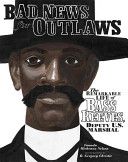
Sitting tall in the saddle, with a wide-brimmed black hat and twin Colt pistols on his belt, Bass Reeves seemed bigger than life. Outlaws feared him. As a deputy U.S. Marshal and former slave who escaped to freedom in the Indian Territories Bass was cunning and fearless. When a lawbreaker heard Bass Reeves had his warrant, he knew it was the end of the trail, because Bass always got his man, dead or alive. He achieved all this in spite of whites who didn’t like the notion of a black lawman.For three decades, Bass was the most feared and respected lawman in the territories. He made more than 3,000 arrests, and though he was a crack shot and a quick draw, he only killed fourteen men in the line of duty. Bad News for Outlaws reveals the story of a remarkable African American hero of the Old West.
- ISBN: 9780822567646
- Author: Nelson, Vaunda Micheaux
- Published: 2009 , Carolrhoda Books
- Themes: African Americans, Frontier and pioneer life, Old West
- Descriptors: Biography - Autobiography- Memoir, Intermediate (ages 9-14), United States
- No. of pages: 40

Ann
Nelson’s book, which won the Coretta Scott King Award in 2009, tells the story of Bass Reeves, an African-American deputy U.S. marshal serving in Indian Territory in the late 1800’s. Reeves comes across as a true tall tale: he was a tall man, fearless, a crack shot with a gun, grew up among the Indians, and, according to Nelson, he “didn’t have a speck of fear in him. And he was as honest as the day is long.”
But the fascinating thing is, Bass Reeves was a real person. He was a true American hero. And, while many children will be caught up in the story of his life, it’s of particular interest for African-American children and families, since Reeves represents a little known chapter in American history.
One of the things I like about this book is that the orientation of the pages conveys the sense of what a large man Bass Reeves was. In fact, the second illustration is a close up of Reeves’ head with a shotgun pointing right at the reader – that image lets us know right away that Bass Reeves was not someone to mess with.
I also like the fact that Nelson includes additional facts at the end of the book, such as a timeline of Reeves’ life, a description of the judge he worked with, and information about Indian Territory, as well as a list of resources for children and teachers who want to learn more about Bass Reeves and the times he lived in.
Celeste
Also included at the end of the book is a glossary of Western terms. I truly enjoyed the way Nelson created a Western atmosphere through language with phrases like “as honest as the day is long,” “their ma was fit to be tied,” and “she…didn’t cotton to lawmen.” I find informational books to be highly engaging when they have a storyteller’s tone, such as this one.
In term of the illustrations, I appreciate the bookending of the story with formal portraits of Reeves, one painted, on photographic. Beginning with the painted portrait, the reader is allowed to access the unbelievability of a tall tale. However, the placement of the photographic image at the end of the story, before the factual addendum, reminds the reader that this character is indeed a true historic figure.
Ann
I heard Vaunda Nelson speak at the 2013 Tucson Festival of Books, and she talked about writing this book. She said that when she first started writing it, she included dialogue, but then she realized that dialogue was an invention, which in turn made the book fiction. She knew Bass Reeves would come across as a character from a tall tale, because even as a historical person he’s larger than life, but she also realized that was why it was so important for children to know about him. She also shared that she tried to write this book in a way that would engage readers, and I think she succeeded.
I wonder how many other historical figures with larger-than-life stories are out there, waiting for an author to find out about them and write a book?
Celeste
Just this summer, Nelson and Bad News for Outlaws were featured in a segment on NPR about the need for a demographics shift within the white dominant publishing community. Children’s books are still largely about white characters for a white audience. So, not only are the stories of larger than life historical figures of color waiting for writers, they are also waiting for the publishers willing to take the perceived financial risks of publishing a multicultural book. Kudos to Lerner Books for publishing Bad News for Outlaws and sharing such a rich and remarkable story with us.